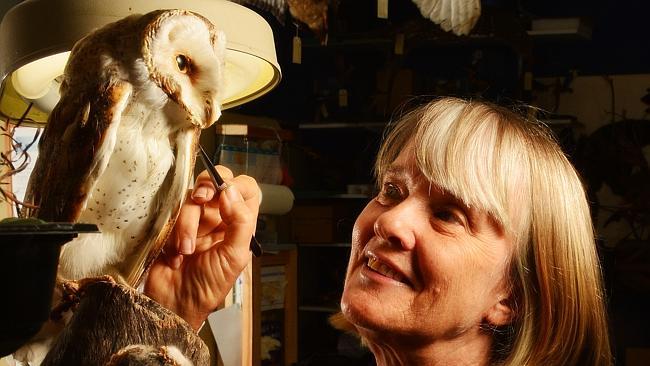U on Sunday: Taxidermist dispels myths of her profession
PEOPLE say ‘oh yuck, blood and guts everywhere!’ But here’s what it’s really like to do one job that others wouldn’t go near.

News
Don't miss out on the headlines from News. Followed categories will be added to My News.
SHARING the wonders of our natural world has been a big part of Beth Snewin’s professional life for more than four decades.
Her own childhood love of the bush and its inhabitants carried into Beth’s classrooms as a kindergarten and preschool teacher across far north Queensland, and flourishes still today in her role as a volunteer taxidermist for the Museum of Tropical Queensland in Townsville.
For the past six years, twice a week, Beth has prepared bird and animal mounts for exhibit as well as giving public talks on the animals, conservation and taxidermy.
“Some people assume there is blood and guts everywhere; taxidermy, oh yuck, how can you? But the bird is already dead. There’s no difference to buying a chicken at the supermarket.
“It’s no worse than preparing meat for tea.’’
She predominantly preserves birds, but also works on mammals. Each specimen takes about three days to prepare.
Animals freshly killed by natural causes or car strikes, for example, are brought into the museum where they are carefully stored in freezers until they can be mounted.
“Instead of just dying by the side of the road and rotting, or being buried, it comes into the museum and it’s basically given a second life, and then it educates people about the wonders of its species, the needs the species has and the conservation issue the particular bird faces.’’
One of three girls born in Ayr, Beth studied at the Brisbane Kindergarten Teachers’ College and spent several years as a kindergarten teacher, later moving into Education Queensland’s preschool system.
“Little kids are like little sponges. They’re so interested in learning, they’re interested in everything around them, their teachers love them dearly and they return that,’’ says Beth, 63.
“I like gardens, I like plants, I like insects. When you’re an early childhood teacher, it’s wonderful because you get to rediscover all these things.’’
Her interest in birds was fostered on a road trip around Australia, when she and a friend decided they needed a hobby to occupy them on the long, lonely stretches of road.
“So we both gave each other a bird book for Christmas, and we started bird watching. It was very difficult, at first. We saw lots of little brown birds that weren’t in the book. You’d think, it’s not in here, it’s a new species!’’ she laughs.
Upon their return, Beth joined the local Birdlife group. It was here museum staff came looking for volunteer taxidermists. Beth and colleague Julia Hazel underwent an initial six weeks’ training, and then another five weeks’ while preserving a cassowary.
Beth’s latest projects include a native water rat and a Little Kingfisher, the second smallest of its kind in the world. This is the first time in her career such a bird has been brought into the museum.
“As a birdwatcher, you might see them fleetingly, a little flash of blue ... flitting like a butterfly across the creek. To be able to hold this tiny, tiny body in your hands, and see the wonder of its feathers and its shape — and think how the hell am I going to get a wire up that leg?! It’s so tiny!”
Beth completed a graduate diploma in special education at James Cook University, and spent the last 16 years of her career as the northern region’s preschool advisory teacher in special education. She retired after taking leave to care for her late father.
“It’s nice to be able to give back, to aid others,” she says. “In these days, there’s a bit too much hurry and children spend so much more time on their iPads and their computers and watching TV.
“The wonders of discovery in the natural world sometimes get left behind, and they’re the things we need to be encouraging our children to do.’’
Beth pauses, then laughs.
“When you’re a teacher, you’re always a teacher. You can’t help yourself.’’
* A Room for Wild Animals showcases 20 taxidermy specimens from the Queensland Museum, including big cats, bears and deer, which usually spend their time in storage. Museum of Tropical Queensland, Townsville until August 30.


